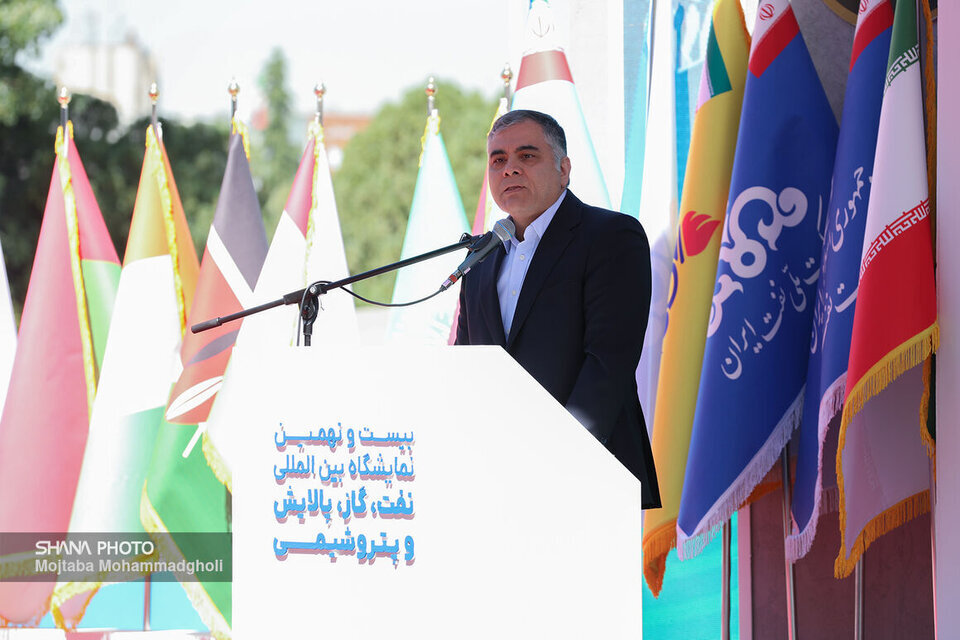Over 2,200 companies attend West Asia's biggest oil industry gathering in Tehran

TEHRAN - Iran's oil industry, a key economic driver, is showcasing its latest achievements at the 29th International Oil, Gas, Refining and Petrochemical Exhibition (Iran Oil Show 2025) in Tehran, where over 2,200 domestic and international companies have convened.
Speaking at the opening ceremony on Thursday, Saman Ghodousi, director of the exhibition, welcomed lawmakers, senior oil officials, foreign ambassadors and delegates. He said the event, hosted at Tehran’s International Permanent Fairgrounds, marks the region’s largest industry gathering, offering opportunities for face-to-face engagement and technology exchange among professionals.
Ghodousi noted that companies from countries including China, Russia, Spain, Italy, the United Kingdom, Switzerland, South Korea, Turkey, India, the UAE, Canada, France, Germany, and Brazil are participating. The event has seen such strong demand that five new exhibition halls have been added to accommodate exhibitors and visitors, alongside expanded open-air sections.
One highlight of this year’s edition is the launch of two virtual platforms, one using artificial intelligence for navigation and company information, and another allowing remote attendees to access the event virtually.
The exhibition runs from May 8 to 11, open daily from 8 a.m. to 3 p.m.
$10b investment to transform Iran's oil industry
At the opening ceremony, Oil Minister Mohsen Paknejad unveiled plans to boost oil and gas production and advance $10 billion worth of projects by the end of the Iranian year 1404 (March 2026). Despite intensified sanctions, he said oil exports remain at peak levels — “just the beginning of our path,” he emphasized.
Paknejad said the exhibition’s theme — Investment in the Oil Industry: A Guarantee for Economic Growth and Development — aligns with Leader Ayatollah Ali Khamenei’s guidance for the new year, highlighting the ministry’s strategic focus.
Covering more than 37 specialized sectors across upstream and downstream operations, financing, trade, and emerging technologies, the exhibition reflects the growing role of innovative startups, tech parks, and research institutions in reshaping the industry.
The minister emphasized the importance of transforming the oil sector with advanced technologies and domestic expertise, pledging strong support for local production and skilled Iranian professionals.
30 major projects and expanded production targets
Paknejad reported notable production increases under President Masoud Pezeshkian’s administration, including an additional 150,000 barrels per day (bpd) of crude oil, 30 million cubic meters per day of raw gas, 180,000 bpd of refining capacity, and 7.0 million tons of annual petrochemical output. Gasoline and diesel production rose by 7.0 and 8.0 million liters per day, respectively.
He added that over 30 large-scale oil projects worth about $10 billion are slated for completion by 2026. These will add 250,000 bpd of oil and 30 million cubic meters per day of gas production capacity.
Easing contracts and attracting energy-intensive investors
The minister praised a recent cabinet decision allowing energy-intensive industries and petrochemical companies to invest in gas field development. The first such contract is expected to be signed during the exhibition.
He also highlighted economic council approvals aimed at improving upstream contract terms, including better internal rate of return (IRR), tax incentives, and bonus payments for surplus output.
To further de-risk and accelerate investment, the ministry is rolling out updated contracts, revised IPC models, public-private partnership schemes, and instruments like the Oil Guarantee Fund, which can issue guarantees of up to $6 billion.
Over 200 investment opportunities unveiled
Paknejad said the ministry is exploring domestic and international funding options, including the National Development Fund and Iranian banks. He expressed hope that over $10 billion in contracts would be signed this year for oil and gas field development.
At a recent upstream investment event, the ministry officially presented over 200 investment opportunities, he noted.
Paknejad said Iran aims to expand regional and international energy markets. He cited the Iran-Russia joint economic commission in early May as a key milestone for bilateral projects, adding that legal frameworks and treaties are being developed to reduce political risk and enable private-sector cooperation.
He also highlighted a newly signed gas swap agreement to deliver Turkmen gas to Turkey via Iran, a move that enhances Iran’s role as a regional energy hub.
The minister reiterated the ministry’s commitment to using emerging technologies, especially artificial intelligence, across the oil and gas value chain.
Push for AI and local equipment in oil, Ptechem industry
Separately, Hassan Abbaspour, Deputy Oil Minister for Petrochemical Affairs, said domestic equipment usage in petrochemical projects is set to increase from 75 percent to 80 percent. He also announced a new utility corridor in Phase 3 of Asaluyeh’s Pars Special Economic Energy Zone to accommodate downstream petrochemical industries.
The ministry is offering incentives, including a 30 percent feedstock discount, to investors entering the downstream sector, as part of a broader effort to complete the petrochemical value chain and reduce semi-raw material exports.
A new research and technology division has been established within the National Petrochemical Company to strengthen domestic production and connect local manufacturers with the industry.
EF/MA
Photo: Oil Minister Mohsen Paknejad speaking at opening ceremony of Iran Oil Show 2025 in Tehran on Thursday, May 8.
Leave a Comment